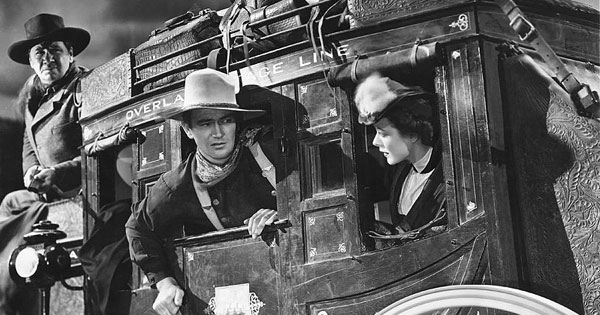
Just watched 40 John Wayne movies in a row. Not all at once, of course (you would have to have a terrible lingering flu for that to happen), but over the course of some months, one film every Friday night, in the quiet company of the house wolf, who curls up on his chair and watches avidly; and I have come to one startling conclusion, and several observations that may be of interest to those of us who are moviegoers and cinephiles and film buffs, which is, to be honest, all of us, because who doesn’t like the movies? No one doesn’t like the movies, because what is it about moving pictures, and filmed narratives, and long-form visual storytelling, that so absorbs human beings? It’s not just Americans who adore the movies, of course; this human pleasure surely derives from storytelling around the fire thousands of years ago, with one early ham or other acting out a story in the flickering light, perhaps with a fellow thespian playing the trusty sidekick, or the alluring love interest, or the dastardly villain … their shadows dancing on the broad bright screen of the wall, their voices changing tone and timbre according to the character, or the danger, or the hero rushing to the rescue …
Which brings us to Marion Robert Morrison, of Winterset, Iowa, who (startling conclusion alert!) might well be the most consistently great American actor ever; who played in an estimated 250 movies over the course of 50 years, beginning with Brown of Harvard, in 1926, in which he played a Yale footballer; who, even when the film he was in was terrible, was not himself anything other than excellent; and who died of cancer after starring in an excellent movie about an aging legend dying of cancer.
I have concluded, after watching most of Wayne’s best movies, a handful of the frenetic one-reelers from the beginning of his career, and a few truly awful movies in which he was the star, that there are three kinds of John Wayne movies.
There is the terrific movie in which he is the star, he is terrific, the rest of the cast is excellent, and the plot and pacing and story and direction are excellent: The Searchers, The Man Who Shot Liberty Valance, True Grit, The Shootist, Operation Pacific, They Were Expendable, She Wore a Yellow Ribbon, The Horse Soldiers, Blood Alley.
Then there are the films in which Wayne is the star, he is terrific, there is at least one other excellent performance, and the story and direction are not total muddle: The Quiet Man, Rio Bravo, Red River, Fort Apache, In Harm’s Way, Flying Leathernecks, McClintock, Rooster Cogburn, Back to Bataan, El Dorado, Donovan’s Reef, The Alamo, Hondo.
Then there are the movies in which he is the star, he is terrific, and the movie is terrible pretty much all around: Legend of the Lost (Sophia Loren?!), The Green Berets, The Train Robbers (Ann-Margret!?), The Three Godfathers, Circus World, Hatari… there are too many to name. Although even with the awful ones, it’s interesting that Wayne is never less than good, and often interestingly oddly good; but in general a John Wayne movie in which he is not wearing a uniform or a cowboy hat may safely be assumed to be a lesser movie, while those in which he wears a badge, a gun, a captain’s cap, or the uniform of the United States armed forces may be safely assumed to be decent. Similarly you can parse by director: almost all of his movies with John Ford and Howard Hawks are excellent.
Back to the sweeping startling conclusion, though: I suspect that John Wayne, dead now 36 years, has become only a figure, a memory, a vague symbol of something or other, depending on your political leanings, or ideas about how much of our American mythology is about courage, murder, independence, racism, violence, and tall hats; but, having just watched a slew of his films, I conclude that he is in the very first rank of American actors, utterly believable in his parts while also somehow being himself, a rare and subtle skill that only a few great actors can manage, surpassing artists of their illusory craft like Cary Grant and Audrey Hepburn and Burt Lancaster and Helen Mirren and the now-forgotten, sadly so, Barbara Stanwyck. Even in the worst movies, he is riveting and convincing; even in the movies that he is propping up alone like a tent-pole, he is commanding and believable; and in his very best movies, like The Man Who Shot Liberty Valence or They Were Expendable, he is so good that you feel what he feels, and you have the oddest feeling when the movie ends, as if a friend or an uncle or a neighbor you admire has just left the house, after an excellent two-hour visit. That is a rare and wonderful artistry, to elicit that feeling from many millions of filmgoers; and so the last line here will be to say, clearly and simply, that John Wayne was a great artist—a word we do not use often or at all about that most interesting man from Iowa, but should.


